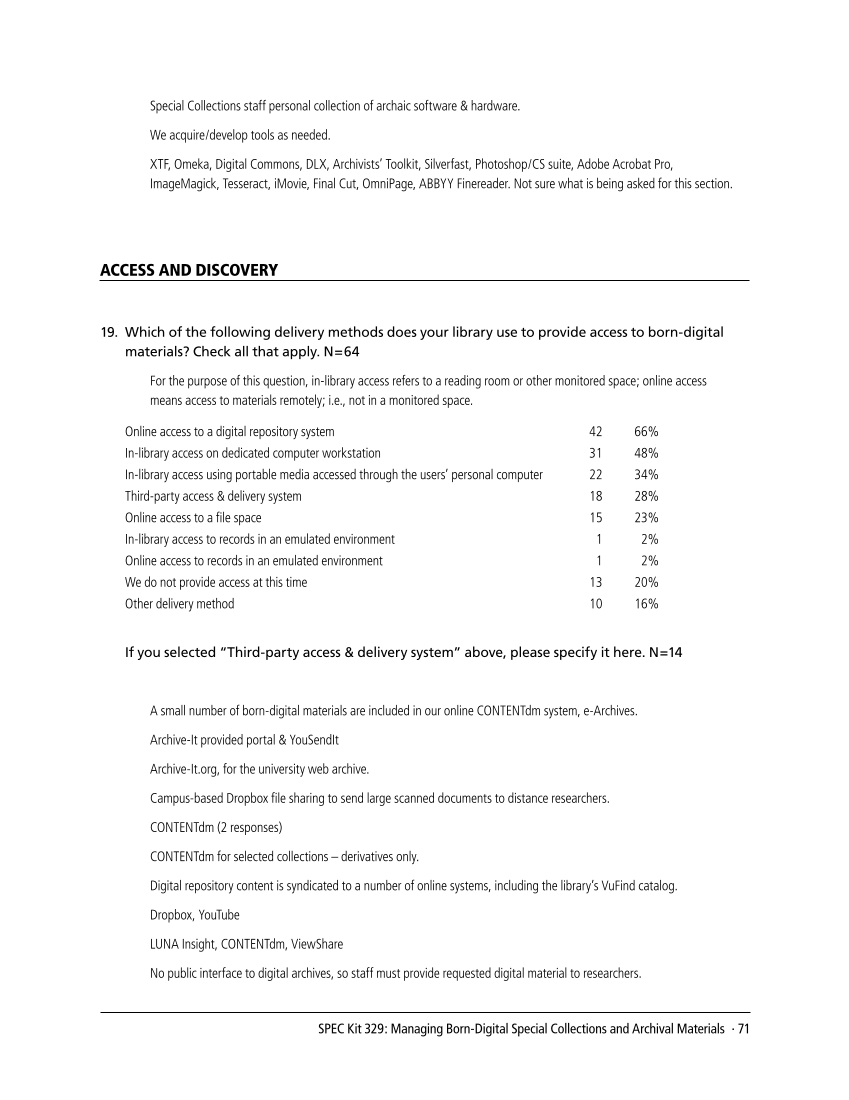SPEC Kit 329: Managing Born-Digital Special Collections and Archival Materials · 71
Special Collections staff personal collection of archaic software &hardware.
We acquire/develop tools as needed.
XTF, Omeka, Digital Commons, DLX, Archivists’ Toolkit, Silverfast, Photoshop/CS suite, Adobe Acrobat Pro,
ImageMagick, Tesseract, iMovie, Final Cut, OmniPage, ABBYY Finereader. Not sure what is being asked for this section.
Access and Discovery
19. Which of the following delivery methods does your library use to provide access to born-digital
materials? Check all that apply. N=64
For the purpose of this question, in-library access refers to a reading room or other monitored space online access
means access to materials remotely i.e., not in a monitored space.
Online access to a digital repository system 42 66%
In-library access on dedicated computer workstation 31 48%
In-library access using portable media accessed through the users’ personal computer 22 34%
Third-party access &delivery system 18 28%
Online access to a file space 15 23%
In-library access to records in an emulated environment 1 2%
Online access to records in an emulated environment 1 2%
We do not provide access at this time 13 20%
Other delivery method 10 16%
If you selected “Third-party access &delivery system” above, please specify it here. N=14
A small number of born-digital materials are included in our online CONTENTdm system, e-Archives.
Archive-It provided portal &YouSendIt
Archive-It.org, for the university web archive.
Campus-based Dropbox file sharing to send large scanned documents to distance researchers.
CONTENTdm (2 responses)
CONTENTdm for selected collections – derivatives only.
Digital repository content is syndicated to a number of online systems, including the library’s VuFind catalog.
Dropbox, YouTube
LUNA Insight, CONTENTdm, ViewShare
No public interface to digital archives, so staff must provide requested digital material to researchers.
Special Collections staff personal collection of archaic software &hardware.
We acquire/develop tools as needed.
XTF, Omeka, Digital Commons, DLX, Archivists’ Toolkit, Silverfast, Photoshop/CS suite, Adobe Acrobat Pro,
ImageMagick, Tesseract, iMovie, Final Cut, OmniPage, ABBYY Finereader. Not sure what is being asked for this section.
Access and Discovery
19. Which of the following delivery methods does your library use to provide access to born-digital
materials? Check all that apply. N=64
For the purpose of this question, in-library access refers to a reading room or other monitored space online access
means access to materials remotely i.e., not in a monitored space.
Online access to a digital repository system 42 66%
In-library access on dedicated computer workstation 31 48%
In-library access using portable media accessed through the users’ personal computer 22 34%
Third-party access &delivery system 18 28%
Online access to a file space 15 23%
In-library access to records in an emulated environment 1 2%
Online access to records in an emulated environment 1 2%
We do not provide access at this time 13 20%
Other delivery method 10 16%
If you selected “Third-party access &delivery system” above, please specify it here. N=14
A small number of born-digital materials are included in our online CONTENTdm system, e-Archives.
Archive-It provided portal &YouSendIt
Archive-It.org, for the university web archive.
Campus-based Dropbox file sharing to send large scanned documents to distance researchers.
CONTENTdm (2 responses)
CONTENTdm for selected collections – derivatives only.
Digital repository content is syndicated to a number of online systems, including the library’s VuFind catalog.
Dropbox, YouTube
LUNA Insight, CONTENTdm, ViewShare
No public interface to digital archives, so staff must provide requested digital material to researchers.










































































































































































































